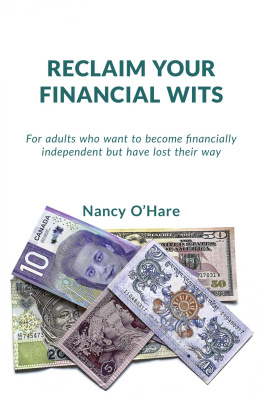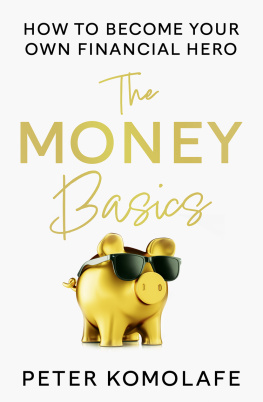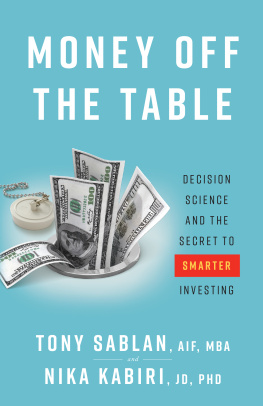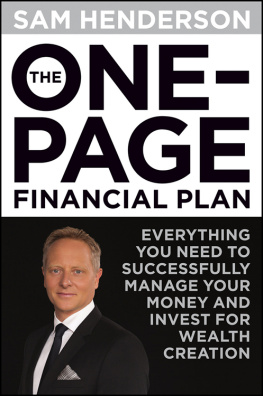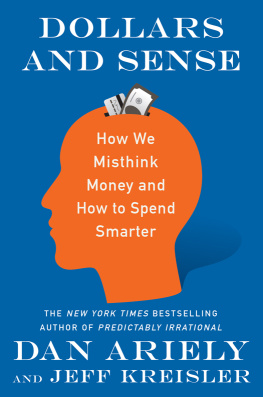Reclaim your Financial Wits
For adults who want to become financially independent but have lost their way
Nancy O'Hare
All rights reserved. No part of this publication may be reproduced, stored in a retrieval system or transmitted, in any form or by any meansby electronic, mechanical, photocopying, recording or otherwisewithout prior written permission from the author, except by reviewers, who may quote brief passages in a review.
For permission requests, email the author at bynancyohare@gmail.com.
Published by Nancy OHare in 2020
Distributed by Smashwords
ISBN: 978-1-7774017-2-6
Photography by Chad OHare
2020 by Nancy OHare
www.bynancyohare.com
The information in this book is true and complete to the best of the authors knowledge. All recommendations are made without guarantee on the part of the author. The author disclaims any liability in connection to the use of this information. None of the products mentioned or reviewed in this book have provided compensation to the author.
Contents
In eight simple steps, learn how to best manage your money and build wealth.
Most people stumble along the way, get distracted or listen to people who would rather grow their own money than yours. This guide shows you how to avoid such pitfalls.
Personal finance is a complex topic. These lessons offer bite-sized advice to start your path towards financial prosperity. For those with enthusiasm to learn more, see the section for additional resources.
By following the learnings in this book consistently, you can reach your financial goals.

Attaining financial freedom allows you to feel like the queen or king of your own castle!

Read on to find your path to financial independence
Lesson One
Starting today, save at least ten percent of everything you earn
What can 10% of your earnings become?
assume a 5.5% return per year and 0.25% MER (see later lessons)
| Monthly Deposit | Value in 10 Years | Value in 20 Years | Value in 30 Years |
| $10 | $1,581 | $4,250 | $8,756 |
| $100 | $15,807 | $42,496 | $87,563 |
| $1,000 | $158,065 | $424,963 | $875,626 |
| $2,000(1) | $316,131 | $849,926 | $1,751,251 |
(1)The more you can save, the wealthier you will become.
Apply this 10% rule to bonuses, extra shifts, raises, tips, another jobeverything you make.
- If you earn $100, save $10.
- If you earn $1,000, save $100.
- If you earn $10,000, save $1,000.
If you can save more than 10%, do it !
If you are starting later in life and need to catch up, aim to save a minimum of 20%. See about a financial plan to determine how much you need to save in order to reach your retirement goals.
Job offer tip : Always ask for a higher salary when initially offered a job, even 5% or 10% extra is worthwhile. This is especially important for women to narrow the gender pay gap.
Lesson Two
Spend less than you earn
Where would you spend an extra $100?
1) One extra day of midrange travel in Vietnam;
2) Dinner for two at your favourite restaurant; or,
3) One pair of jeans.
This example is meant to help you prioritize what gives you the most value. If you could only have one, which would you choose?
Put a portion of your earnings towards expenses you need to buy. These are costs you cannot survive without: food, shelter, health care and transportation.
If not already deducted from your pay, save a portion for any taxes owed to the government. You cannot avoid taxes, so be sure to put this money in a very safe and accessible place like a high-interest savings account (HISA) with a reputable financial institution.
Spend any remaining earnings on other things you want . Remember, extra beverages, excessive clothing, fancy cars, drugs, alcohol, weekend getaways and overseas vacations are wants . This is all about choices. Choose what truly adds value to your life.
Patience tip : Wait for items to go on sale and get the same thing for less of your money.
Proactive tip : For big purchases, always ask for a discount.
Decision-making tip : It might help to ask yourself, what will I remember and value in one-years time when I look back?
Stock Markets are where shares of public companies are bought and sold. Most countries have a stock market for owners of businesses registered in that country who want to sell pieces of their company to other people. Pieces of the company are called stock, shares or equity.
Why dostockmarket movementsdiffer fromwhat you seehappeninginyourlocal economy? Local businesses such as restaurants, gyms and trades are often not listed on the stock market. They are private businesses and their profits or losses are not picked up in public stock exchange results.
Investment-grade bonds are a type of loan thought to be fairly safe. Independent credit rating agencies rank borrowers based on their credit risk, such as AAA, AA, A or BBB. These particular ratings are all considered to be investment grade. Any lower rating is viewed to have low credit quality. What does this mean? A higher credit rating means the company or government borrowing money (via a bond) has a better chance of repaying you, the lender. Likewise, a low credit rating indicates the borrower is more likely to default (not repay) you, the lender.
By putting some of your money into safer fixed income investments, you give yourself a buffer from the ups and downs of the stock markets. Fixed income investments generally earn less money than equity, usually in the form of interest. This is your protection money .
By putting some of your money into equities , you give yourself the chance to grow your money and the chance to lose your money. Equity generally earns more money than fixed income over the long term, but it has more volatility (ups and downs). This is your growth money .
Exchange Traded Funds (ETFs) are collections of stocks and/or bonds that track or mimic underlying indexes or markets. Mutual funds are similar baskets of stocks and/or bonds that are selected by fund managers and typically have different fee structures than ETFs. For further clarification between ETFs and mutual funds, go to https://investor.vanguard.com/etf/etf-vs-mutual-fund.
Lesson Three
Decide your savings strategy

